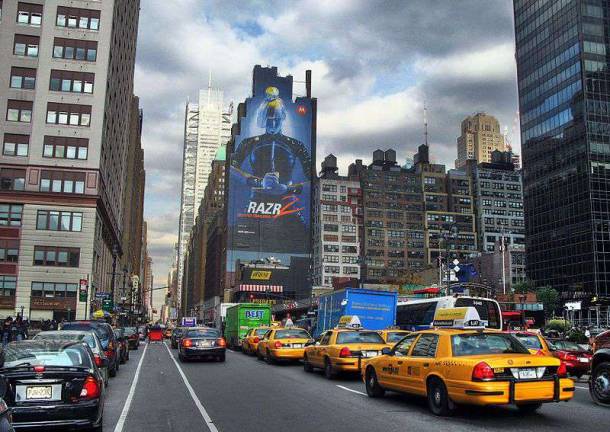Experts Debate Traffic vs. Tolls for East River Bridges

If there is anything that makes sane people act crazy, it's traffic. In Manhattan, transportation congestion is a constant problem, causing safety risks, environmental issues and extensive time delays. On Thursday, May 10, Community Board 2 and New York University hosted the panel discussion "Dealing with Downtown Bridge Traffic: Are Tolls the Answer?" The four members of the panel discussed the possibility of tolls for the East River bridges and the benefits of congestion pricing. Throughout the event, audience reaction was sometimes angry and always loud. (By Courtney Holbrook for Our Town Downtown.) "Traffic is just a pain," said Shirley Secunda, chair of the Traffic and Transportation Board of CB2 and the panel moderator. "Traffic overruns our neighborhoods, blocks people from commuting, affects safety, causes air pollution and loud noises, threatens our vulnerable historic infrastructure and impedes the conduct of business." The four members of the panel were Kate Slevin, executive director of the Tri-State Transportation Campaign (TSTC); Paul Steely White, executive director of Transportation Alternatives; Hope Cohen, associate director of the Regional Plan Association's Center for Urban Innovation; and Charles Komanoff, an energy policy activist and transport economist. The members came to an agreement about the benefits of tolls on the East River bridges, which carry travelers from Brooklyn to Manhattan. "Currently, on the isle of Manhattan, bridges and tunnels are operated under three different policies and price structures," Cohen said. "For example, the Hudson River Tunnel is owned by the Port Authority. It charges tolls, and that bridge is in the best condition." New York State, however, controls the East River bridges; they are paid for through tax revenue rather than tolls. According to Cohen, the lack of tolls on the East River bridges creates "an uneven distribution of traffic patterns?if you were to install tolls, you would level out the pricing of the different crossings into Manhattan, and thus lead to a more evenly distributed traffic pattern." Komanoff acknowledged that the process of proving the benefits of such an action would require some political maneuvering. "We don't want to create a war on the car," Komanoff said. "But we need to change the car from a sacred cow to a cash cow. If we want to improve our pollution and our traffic, we can't ban cars-we must bill cars." The next question raised was where, besides on the East River bridges, tolls would be most effective. Cohen noted that the tolls could not be issued in isolation. In fact, some of the most-trafficked roads were not in Manhattan-the BQE, the Staten Island Expressway and the Long Island Expressway. "If we don't deal with those traffic issues elsewhere as well as those in Manhattan, we take the risk of creating a certain political argument," Cohen said. "We play into the idea of Manhattan as this elite fortress wanting to keep everyone out. We must attend to other traffic problems as well." At this point, a specific cost for those tolls is unavailable, though the plan suggested by CB2 would make tolls comparable to those on the other tolled bridges. Slevin insisted tolling would not render Manhattan a "fortress of elites," keeping low-income households out. According to a study conducted by TSTC in 2007, Brooklyn households without vehicles earned an average yearly income of $32,000. Households with vehicles earned almost double that figure. The average yearly income of Bronx residents without a vehicle was $27,000; those with a vehicle earned a median yearly income of $60,000. "The facts can show that only 2.5 percent of our lowest-income earners would be affected by the congestion charge," Slevin said. "If we, in turn, took the money we earned from the tolls and directed it toward public transport-the transport those low-income workers use-we would be creating one of the most progressive pieces of legislation in years." The idea of donating funds generated from tolls to the MTA transport system was met with support from the rest of the panel. Currently, vehicles traveling the two tolled tunnels contribute more than $200 million per year. If the free East River bridges had tolls, the MTA could earn approximately $800 million per year in new revenue. These funds would offset transit service cuts, according to a statement issued by CB2 to Gov. Andrew M. Cuomo. Slevin noted the funds would need extensive monitoring. "We have to be able to give the funds directly to the MTA, not Albany," Slevin said. "Once the funds go to Albany, they have to be allocated to an agency and then they can get tied up in other projects." In order to ensure the funds from tolls would go to cheaper, improved transit, transportation boards would have to "set up an entity within the MTA to protect revenues," Slevin said. Certain audience members protested they opposed congestion pricing because they had to drive for health or job reasons. Some opposed tolls and congestion pricing in general. But most agreed traffic was a problem that needed a solution. The panel encouraged audience members to contact their legislators and push for change. White noted these ideas would help New York City take "control of its transit destiny and improve the city's transportation efficiency."